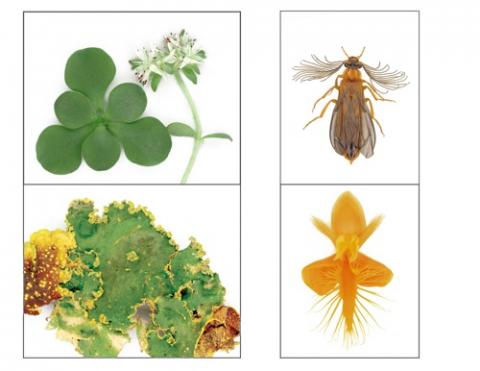Visit the Sugarlands Visitor Center at Great Smoky Mountains National Park in the coming months and you'll come away with a true appreciation of art in nature. Through year's end a sampling of the life forms that the All Taxa Biodiversity Inventory has turned up in the park will be on display in the visitor center.
Discover Life in America is involved in a quest to identify and understand all the species of life within the park's 800 square miles. DLIA researchers seek knowledge about the components, abundance, and diversity of life, from spiders in the soil to slime molds in the forest canopy. The primary tool of DLIA is the All Taxa Biodiversity Inventory, which brings scientists from around the world to inventory the estimated 100,000 species of living organisms in Great Smoky. The project develops checklists, reports, maps, databases, and natural history profiles that describe the biology of this rich landscape to a wide audience. DLIA’s mission is to help the ATBI identify and develop resources and partnerships to conduct the inventory and related educational activities.
The All Taxa Biodiversity Inventory is described as one of the world's biggest and most ambitious science projects, aiming to decipher the mysteries of the Smokies' intricate ecosystem by finding and cataloging every species of plant, animal and microorganism in the park. Since species collecting began in 1998, the ATBI has uncovered more than 900 species new to science, as well as more than 6,400 species that are newly documented to exist in the Smokies.
By completing this comprehensive inventory of species, National Park Service managers are able to use this basic knowledge in their critical decision-making. The data resulting from this project allow for park management attention to be focused on organisms and habitats with special needs as well as more efficient maintenance of healthy populations of species and their ecological surroundings. It also provides a baseline record for the examination of global factors such as acid rain, climate change, and pollution-knowledge that is essential for this national park’s biodiversity to be preserved for future generations to enjoy. To learn more about Discover Life in America and the ATBI project, visit www.dlia.org.
The Sugarlands Visitor Center, located just inside the park's Gatlinburg, Tennessee, entrance, is open every day except Christmas Day.
Hours:
October – 8 a.m. – 6 p.m.
November – 8 a.m. – 5 p.m.
December – 8 a.m. – 4:30 p.m.




Add comment